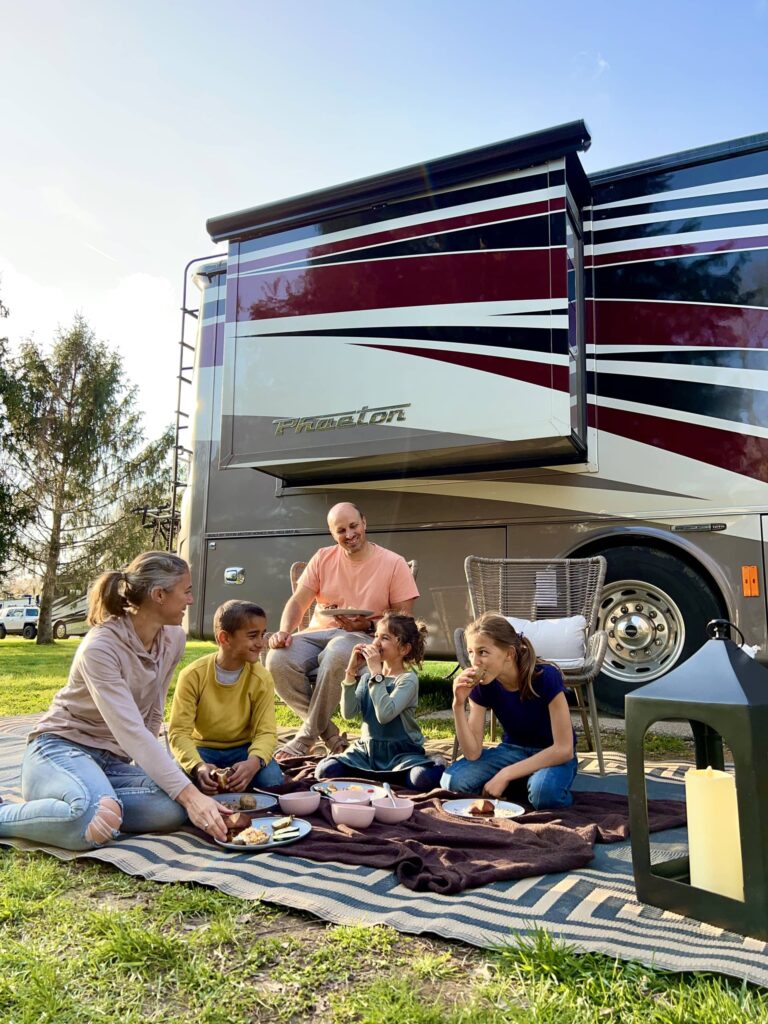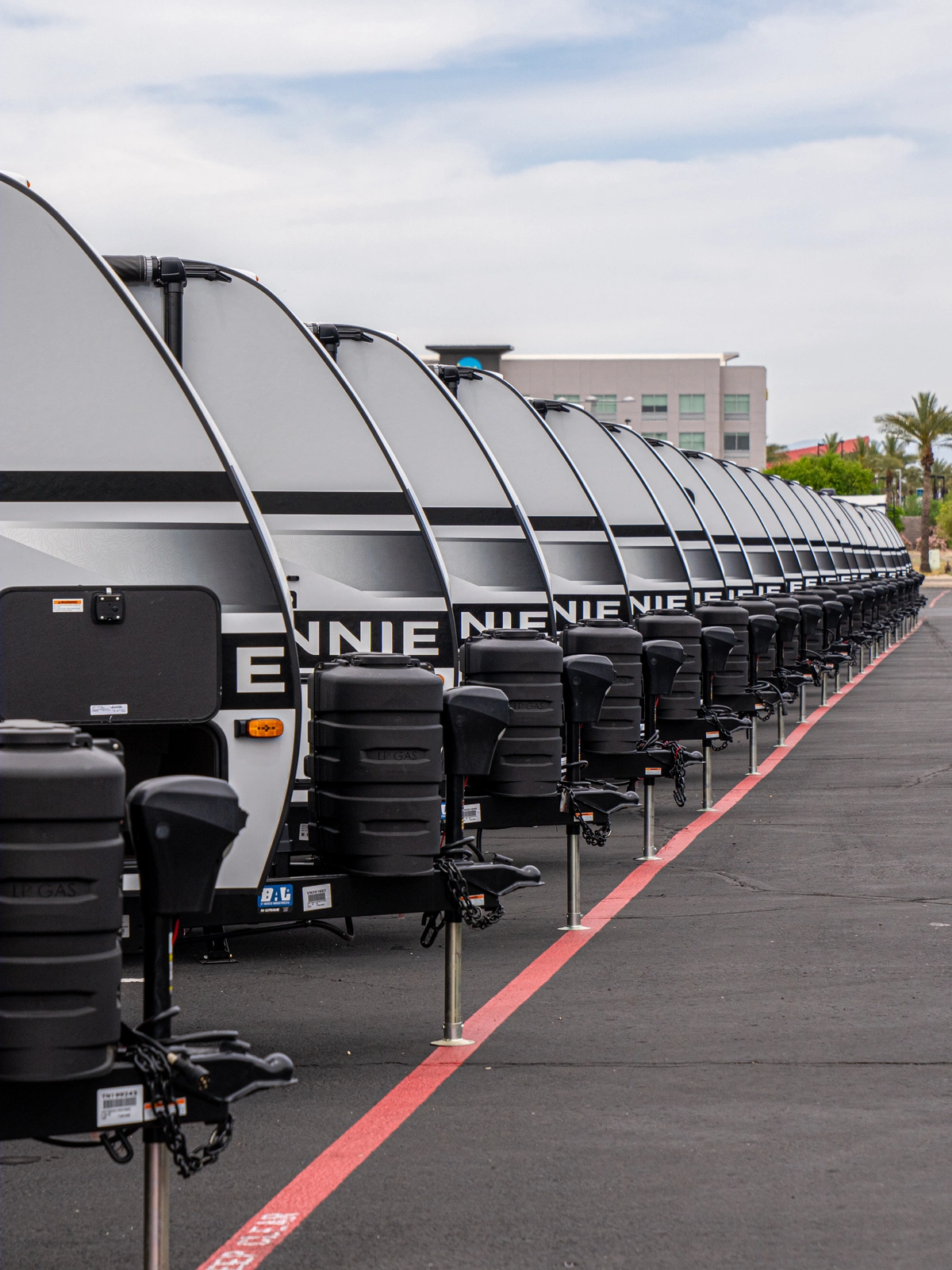While each type of RV has its own specific requirements, there are a few essentials that are must-haves for every RVer. I will limit this list to ten items every RVer needs (+ a bonus one for travel trailers and fifth wheels), but if you and I were to talk, I would be unstoppable. For all the details, check out our must-have list of items every RVer needs below!
Guest Post and Photos by Laura Georgieff
Wheel Chocks
No matter the type of RV or van you drive, we suggest investing in chocks.
RV chocks can be used in several situations, and you should at the very least place one in the front and one in the back of each wheel when parking at the campground. They prevent your trailer from moving and will be especially useful as you unhitch / re-hitch, or when parked on uneven terrain. Our fifth wheel had double wheels, so the front wheels had a chock in the front, and the back wheels had a chock in the back.
While we don't use chocks while parked with our Class A motorhome, we have used them while parked on tilted parking lots, or even to lock our tow vehicle in place when parked, to avoid it putting weight on the tow bars.
RV Doormat
Camping can be dirty business. You walk in and out of your RV often, with sand or mud under your shoes. We suggest a powerful door mat that can be easily shaken clean and which drys quickly! Regular household mats get too wet and take too long drying to be convenient while RVing. RV outdoor door mats are made of a flexible rubber and work exactly as needed.
If your cargo space allows, I personally highly recommend an RV outdoor rug. Those are made of plastic straw, easy to brush off, long lasting, light, and quick drying! They extend your living space to the outdoors and create an inviting space to use outside.
Stabilizing Jack Pads
This is one of the products we left without and purchased almost immediately after the start of our first roadtrip - stabilizing jack pads. You will notice the yellow hard plastic pads in every campground. You place them under your jacks to prevent your rig from sinking and/or shifting on soft soil and gravel.
The only time we do not use our stabilizing jack pads is when parked on a concrete slab. Any other time, you will find one under each of our jacks for reliable stability. Heavier Class A and Class C motorhomes can also do without, since they have their tires to add stability. Many travel trailers will prefer using leveling blocks to help level their trailer at the same time.
Surge Protector
Our surge protector has saved the electronics on board our RV multiple times. You will want to choose the model that works for the amps in your rig. When available, we plug into 50 amps, but if you have a 30 amp RV, purchase a 30 amp surge protector.
The surge protector is what you will plug into the power box at the campgrounds,. You then plug your RV plug into the surge protector. It has worked for us in every weather and temperature, and it tripped several times, indicating a temporary or permanent issue with the campgrounds' power.
Water Pressure Regulator
An RV water pressure regulator is a must, since you cannot control the water pressure at campgrounds. We have heard a number of horror stories - pipes bursting inside RVs, or worse... but with a water pressure regulator you can easily prevent the problem.
A water pressure regulator is plugged between the campground's water outlet and your hose. It monitors and adjusts the water pressure before it hits your fresh water hose. We have had just one issue with ours, and hopefully I can prevent that mishap from happening to you. It froze and the glass piece cracked when we camped in -17 degrees, in Kansas City. The water had frozen anyways and we should not have taken the regulator, or our hose out, anyways. Both froze and cracked...
Outside of extreme freezing temperatures, a water pressure valve will be a life-saver, but also always remember to turn the water off when leaving the campground for several hours!
Sewer Hose + Clear Sewer Connector
This one goes without saying, but if you plan on using any water on board your RV (even if just sink water, and not the toilet), you will need a sewer hose to empty your tanks. My word of advice? Get one with plenty of length. We suggest one that is at least 30 feet. You don't want to have to pull on those hoses in any direction.
This one may be counter-intuitive because, who wants to be looking at poop? Well... the answer is, you! Yep. I know... but we suggest buying a clear RV sewer hose elbow to connect your sewer hose to the campground's sewer pipe so you can watch as you empty. Start by emptying the black tank, then run your grey waters and watch as the liquid turns "clear". If needed, flush your tanks by adding some fresh water (with a regular hose, not your drinking water hose!) and empty until clearer liquid flushes out.
Drinking Water Hose + Filter
I remember learning one day, a few weeks before leaving for full-time RVing, that regular hoses were not to be used with drinking water. Of course that made sense after thinking about it, but it had never occurred to me that drinking water hoses where a thing.
A lead-free and BPA-free hose will be safe for drinking, and should be the only hose you hook up to your pressure valve, if you have the intention of consuming the water, or filling up your fresh water tank. I recommend adding this filter to your hose, as a first filter towards a cleaner water.
If you plan on camping in freezing temperatures, you will need a heated drinking water hose. As I mentioned above, your hose will freeze, crack, and need full replacement, if you leave it out with water in it, in below-freezing weather.
I recommend always having a regular water hose with you as well, for any time you need to flush your tanks, wash your feet, your furry friend, etc.
Sewer Hose Support
A sewer hose support is a must. You cannot believe how many times sewer pipes are built above ground level (probably to avoid them flooding). That support system is angled and your hose will rest on it, guiding it downhill to keep the waste moving down. Again - be safe and get plenty of length!
Keyless Entry Keypad
I couldn't live without this one...a keyless entry keypad is so convenient! You will be coming in and out, and if you have kids, that will only multiply the number of people needing access to the key. With a keyless entry keypad, program a code to lock and unlock your RV door, making it easy and quick for all family members to access your rig.
Another benefit of the keyless entry keypad is the ability to let someone in, from the campground, in case of an emergency. We hope you are never in that situation, but should you be, those can be a life-saver!
Black Tank Pods
RV toilet treatment drop-ins are little pods similar to home dishwasher tabs, that you drop into your black tank though your toilet, to break down waste in the tank.
Use those as needed, when your bathroom starts smelling or earlier. The formula in the drop-ins breaks down the waste and tissues, which helps with smell and can even remove waste from sensors.
Bonus For Travel Trailers And Fifth Wheels - X-Chocks Stabilizers
This one only applies to travel trailers and fifth wheels when you have a double wheel base. Invest in quality metal x-chock wheel stabilizers.They make a world of a difference in the stability of your rig when living in it. If you are disturbed by people walking around the rig and the RV shaking, you will be stunned to find how much of a difference x-chocks make!

RV 101: The Top 10 Items Every RVer Needs
I sneaked a couple extras here and there, but this list should give you a head start on your camping trip. You can confidently purchase all of the items on this list, and it will be money well spent. Most of the items are below $30, while others are a little more of an investment, but all will make your life RVing a lot more convenient and/or safer.
Happy adventuring!


